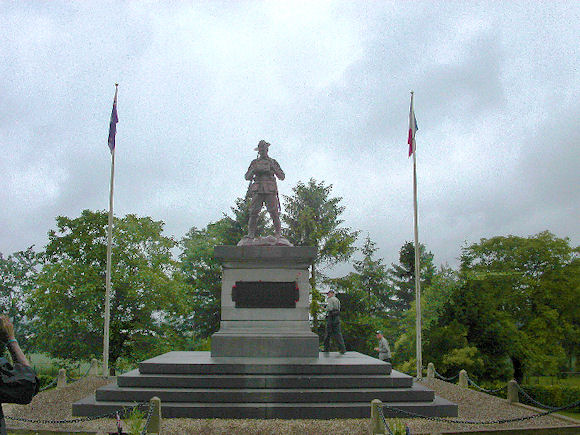By Michele Bomford
Big Sky Publishing, 2015
Peter L. Belmonte, Reviewer
Peter L. Belmonte, Reviewer
 |
| Australian Troops Approach the Crest of Mont St. Quentin |
Lost between what many consider the turning point of the war, the Second Battle of the Marne in July 1918, and the start of Marshal Ferdinand Foch's big push beginning with the American attack in the Meuse-Argonne in late September, is the Australian attack on Mont St. Quentin-Peronne on the Somme river in late August to early September. Bracketed as it was by French, American, and British successes in July and August, and the start of the final push, it's easy to understand why the relatively small-scale offensive has not been given much attention. Australian historian Michele Bomford handily rectifies that situation with this fine book, a revision and expansion of her previous work, and a part of the Australian Army Campaign Series, published by the Australian Army History Unit in Canberra.
Bomford covers in detail the series of attacks by the Australian Corps against the German positions in the Mont St. Quentin-Peronne area from about 30 August through 5 September. The author rightly states that by this time the nature of the war had changed. The Allies were now on the offensive, and "open warfare" was to be the order of the day. This represented a departure from the standard practice of Lieutenant General Sir John Monash's Australian Corps. This would not be a "set-piece battle devised after days or perhaps weeks of meticulous planning and which utilized every available mechanical resource then available to the Allies on the Western Front" (p. vi). Rather, this was to be a mobile, free-flowing series of quick attacks.
This book can be considered a primer on the Australian military in 1918. The author assesses Australian command and staff structure and concludes that by August 1918 it was operating at peak efficiency. Australian tactics had evolved to better operate in a mobile warfare environment. Bomford includes full-page "side bars" of weapons including rifles, bayonets, machine guns, hand grenades, mortars, artillery pieces, and airplanes. She also emphasizes the accomplishments of junior officers and enlisted men, rightly giving them credit for initiative and perseverance. Accordingly, the author records specific acts that earned men the Victoria Cross, the United Kingdom's highest award for battlefield bravery. Many men are highlighted in sidebars. Bomford also provides a brief but interesting analysis of how British commanders viewed this battle and its place in the larger events of August and September 1918.
It is interesting to note that even at this late stage in the war the Australians experienced some of the same problems that the Americans, comparative newcomers, experienced. Poor command and control, insufficient and often ineffective artillery support, tactics issues, and out of touch commanders, all plagued the Australians to varying degrees during these battles, yet Bomford retains the proper perspective and does not indulge in unrealistic criticism. Frankly, American historians can learn a lesson from this author's circumspection and understanding of the problems that confronted Great War commanders.
Those who appreciate good maps in military history books will be absolutely delighted with this book. Several large-scale maps highlight the action and make the narrative easy to visualize. The only real drawback to this book is its lack of end notes. Usually, but not always, a reader can easily determine the origin of a quotation in the text. Those who like to read about small-unit actions will enjoy this book that often covers the battle, fought by an entire corps, at the battalion level. This book is highly recommended as an important and readable addition to World War I historiography; it well illustrates a battle that could be considered comparatively small but important.
Peter L. Belmonte
Bomford covers in detail the series of attacks by the Australian Corps against the German positions in the Mont St. Quentin-Peronne area from about 30 August through 5 September. The author rightly states that by this time the nature of the war had changed. The Allies were now on the offensive, and "open warfare" was to be the order of the day. This represented a departure from the standard practice of Lieutenant General Sir John Monash's Australian Corps. This would not be a "set-piece battle devised after days or perhaps weeks of meticulous planning and which utilized every available mechanical resource then available to the Allies on the Western Front" (p. vi). Rather, this was to be a mobile, free-flowing series of quick attacks.
 |
| Monument to the Australian 2nd Division on Mont St. Quentin |
Those who appreciate good maps in military history books will be absolutely delighted with this book. Several large-scale maps highlight the action and make the narrative easy to visualize. The only real drawback to this book is its lack of end notes. Usually, but not always, a reader can easily determine the origin of a quotation in the text. Those who like to read about small-unit actions will enjoy this book that often covers the battle, fought by an entire corps, at the battalion level. This book is highly recommended as an important and readable addition to World War I historiography; it well illustrates a battle that could be considered comparatively small but important.
Peter L. Belmonte

A nicely balanced account. Another book I'm going to have to read! Thanks, Pete.
ReplyDelete"Several large-scale maps highlight the action and make the narrative easy to visualize" - HURRAH!
ReplyDeleteI recently borrowed this book from my local public library - an excellent read.
ReplyDelete